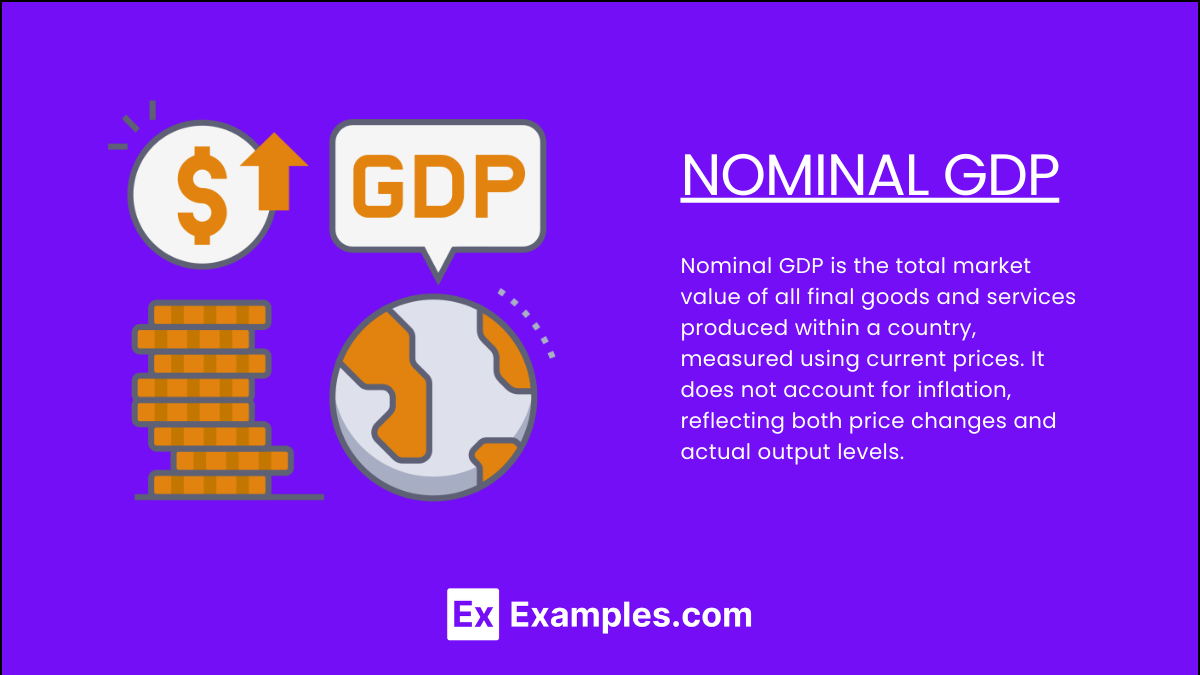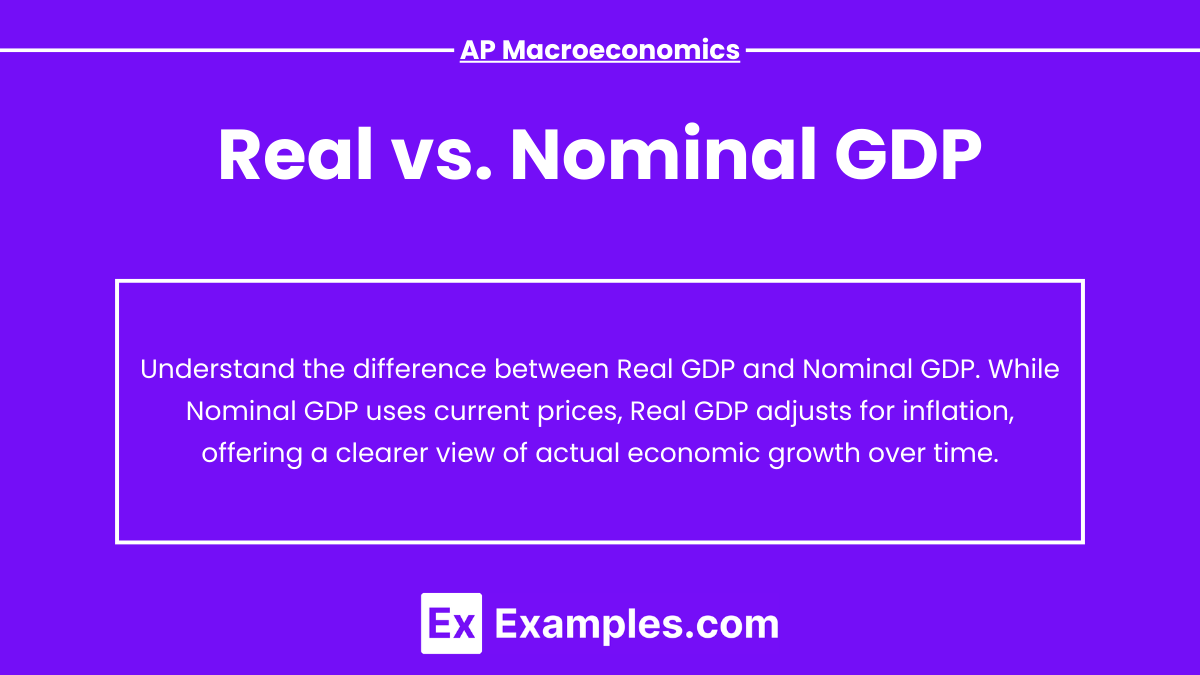In AP Macroeconomics, understanding the distinction between Real GDP and Nominal GDP is essential for analyzing economic performance. Nominal GDP measures a country’s output using current prices, while Real GDP adjusts for inflation, reflecting actual growth. This comparison helps assess true economic progress and guides effective policy decisions.
Learning Objectives
For the AP Macroeconomics exam, you should understand the definitions of Nominal GDP and Real GDP, how to calculate both, and the significance of adjusting for inflation. Learn how the GDP deflator links the two and why Real GDP provides a more accurate measure of economic growth over time.
GDP

Gross Domestic Product (GDP) is the total market value of all final goods and services produced within a country’s borders in a specific time period, typically measured annually or quarterly.
- Nominal GDP is the value of all goods and services produced within a country using current prices.
- Real GDP adjusts for inflation and reflects the value of goods and services at constant prices, using a base year for comparison.
1. Nominal GDP

Nominal GDP measures a nation’s economic output based on current prices. It includes changes in both the quantity of goods and services produced and the prices at which they are sold.
Characteristics of Nominal GDP:
- Current Prices: It uses the prices at the time the goods and services are produced.
- Inflation: Nominal GDP does not account for inflation, meaning it can give a misleading impression of economic growth if inflation rates fluctuate.
- Higher in Inflationary Periods: When inflation is high, nominal GDP tends to be artificially inflated, even if the actual output remains constant.
Example:
If the economy produces 100 cars in Year 1, priced at $30,000 each, and 100 cars in Year 2, but the price rises to $32,000 due to inflation, the nominal GDP would show an increase, even though the number of cars produced hasn’t changed.
| Year | Cars Produced | Price per Car | Nominal GDP |
|---|---|---|---|
| 1 | 100 | $30,000 | $3,000,000 |
| 2 | 100 | $32,000 | $3,200,000 |
2. Real GDP

Real GDP is adjusted for inflation, allowing for a more accurate measure of an economy’s growth by using constant prices from a base year. It removes the effects of price changes over time, isolating the quantity of goods and services produced.
Characteristics of Real GDP:
- Constant Prices: It measures economic output using prices from a selected base year, removing the effects of inflation.
- True Economic Growth: Real GDP provides a clearer picture of economic performance because it reflects changes in actual production rather than price level changes.
- Used for Comparisons: Real GDP is used to compare economic output across different years, as it shows the growth in the quantity of goods and services.
3. Key Differences Between Real and Nominal GDP
| Aspect | Nominal GDP | Real GDP |
|---|---|---|
| Price Level | Uses current prices | Uses constant prices (base year) |
| Inflation | Includes effects of inflation | Adjusts for inflation |
| Economic Growth | May overstate or understate growth | Accurately reflects true economic growth |
| Best for Comparisons | Not ideal for comparing across years | Best for comparing economic performance over time |
| Impact of Price Changes | Affected by changes in price levels | Reflects changes in actual production, not prices |
4. Importance of Real GDP in Economic Analysis
Real GDP is a more reliable measure when analyzing the health and performance of an economy for several reasons:
- Comparing Economic Performance: Real GDP allows for comparisons across different years, as it eliminates the distortions caused by inflation or deflation.
- Policy Making: Economists and policymakers use real GDP to assess whether an economy is growing, stagnating, or shrinking in terms of actual production.
- Standard of Living: Real GDP per capita (Real GDP divided by the population) is a critical measure of the standard of living, as it accounts for both inflation and population changes.
5. GDP Deflator: Linking Real and Nominal GDP
The GDP deflator is an index used to convert nominal GDP into real GDP. It measures the overall change in prices within the economy.
- Formula:

- Use: The GDP deflator shows how much of the change in GDP is due to changes in the price level (inflation) rather than changes in the quantity of goods and services produced.
Example:
If the nominal GDP is $3,200,000 and the real GDP is $3,000,000, the GDP deflator would be:
![]()
A GDP deflator of 106.67 means that prices have increased by approximately 6.67% since the base year.
Examples
Example 1: GDP Growth with Inflation
Nominal GDP in 2023 rises 8% due to inflation, but Real GDP only grows by 2%, showing minimal actual economic growth.
Example 2: Comparing Two Years
If Nominal GDP increases 10% between 2020 and 2021, but Real GDP only increases 4%, inflation accounts for the remaining 6%.
Example 3: Price Hike Impact
A country’s Nominal GDP jumps due to rising oil prices, but Real GDP stays constant, indicating no change in actual production.
Example 4: Economic Decline
Nominal GDP remains steady during a recession, but Real GDP falls 5%, highlighting that output has shrunk once inflation is factored in.
Example 5: GDP Deflator Calculation
Nominal GDP grows by 15%, but with an inflation rate of 10%, Real GDP growth is just 5%, showing how the GDP deflator adjusts for price changes.
Question 1
Which of the following best defines Nominal GDP?
A) GDP adjusted for inflation
B) GDP measured using current prices
C) GDP that only includes exports
D) GDP using base-year prices
Answer: B) GDP measured using current prices
Explanation: Nominal GDP is calculated using the prices of goods and services in the year they are produced, without adjusting for inflation.
Question 2
If Nominal GDP increases by 6% but inflation is 4%, how much did Real GDP grow?
A) 2%
B) 4%
C) 6%
D) 10%
Answer: A) 2%
Explanation: Real GDP accounts for inflation. The 6% nominal increase minus 4% inflation shows actual economic growth of 2%.
Question 3
Which of the following is true about Real GDP?
A) It measures GDP in current prices.
B) It accounts for inflation using a base year.
C) It always shows higher values than Nominal GDP.
D) It only includes government spending.
Answer: B) It accounts for inflation using a base year.
Explanation: Real GDP removes the effect of inflation by using constant base-year prices, providing a clearer measure of economic growth.


